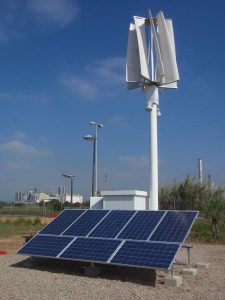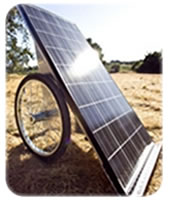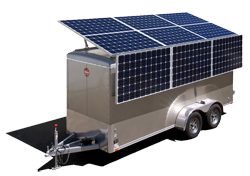Cities, towns, counties, states, regions, and countries all over the world are making large strides towards shifting to renewable energy sources (e.g., solar, wind, geothermal, hydropower, biomass, and wave/tidal energy). In early 2018 we published our original post on this topic. This new post provides an update on where things stand three years later, in early 2021:
 Within the U.S., the Sierra Club’s Ready for 100 program reports that (to date, as of early 2021), more than 170 cities, more than 10 counties, 8 states, and 2 territories have adopted the ambitious goal of 100% clean energy (for at least electricity). Note: This is quite a bit more than just three years ago, when the stats were 50 cities, 7 counties, and only 1 state (Hawaii). As of this year (so far), the 8 states and 2 territories that have committed to this goal are: California, Hawaii, Maine, New Mexico, Nevada, New York, Virginia, Washington, as well as Washington D.C. and Puerto Rico! The counties that have made this commitment are located in California, Colorado, Idaho, North Carolina, New Mexico, Oregon, Virginia, and Washington state.
Within the U.S., the Sierra Club’s Ready for 100 program reports that (to date, as of early 2021), more than 170 cities, more than 10 counties, 8 states, and 2 territories have adopted the ambitious goal of 100% clean energy (for at least electricity). Note: This is quite a bit more than just three years ago, when the stats were 50 cities, 7 counties, and only 1 state (Hawaii). As of this year (so far), the 8 states and 2 territories that have committed to this goal are: California, Hawaii, Maine, New Mexico, Nevada, New York, Virginia, Washington, as well as Washington D.C. and Puerto Rico! The counties that have made this commitment are located in California, Colorado, Idaho, North Carolina, New Mexico, Oregon, Virginia, and Washington state.
Whereas three years ago, only five towns in the U.S. had achieved this impressive goal (generating 100% of their electricity from non-polluting, renewable sources), now five counties (unincorporated county areas) in California, as well as 47 cities and towns across the U.S. have achieved this goal. Most of those cities and towns are in California. The non-California towns are: Aspen, CO; Greensburg, KS; Rock Port, MO; Kodiak Island, AK; and Georgetown, TX. You can use the Sierra Club’s Ready for 100 map to see if your city/town/county or other municipalities in your state have committed to or achieved these renewable energy goals.
 Worldwide, many other cities and countries are also approaching and even reaching 100% renewable electricity goals. The Global 100 RE Strategy Group says that “To date, 11 countries have reached or exceeded 100% renewable electricity; 12 countries have passed laws to reach 100% renewable electricity by 2030; 49 countries have passed laws to reach 100% renewable electricity by 2050; 14 U.S. states and territories have passed laws or executive orders to reach up to 100% renewable electricity by between 2030 and 2050 [Note: That is more than the 10 identified by the Sierra Club above]; over 300 cities worldwide have passed laws to reach 100% renewable electricity by no later than 2050; and over 280 international businesses have committed to 100% renewables across their global operations.”
Worldwide, many other cities and countries are also approaching and even reaching 100% renewable electricity goals. The Global 100 RE Strategy Group says that “To date, 11 countries have reached or exceeded 100% renewable electricity; 12 countries have passed laws to reach 100% renewable electricity by 2030; 49 countries have passed laws to reach 100% renewable electricity by 2050; 14 U.S. states and territories have passed laws or executive orders to reach up to 100% renewable electricity by between 2030 and 2050 [Note: That is more than the 10 identified by the Sierra Club above]; over 300 cities worldwide have passed laws to reach 100% renewable electricity by no later than 2050; and over 280 international businesses have committed to 100% renewables across their global operations.”
Countries that are powered or almost entirely powered on renewable energy (>90%) include: Costa Rica, Iceland, Uruguay, Paraguay, and Norway. Other countries with very high percentages of renewables include Portugal, Germany, Scotland, New Zealand, and Austria. Islands that now have >90% renewable electricity include: Eigg and Orkney (Scotland), Tasmania (Australia), Tokelau (New Zealand), Tau (American Samoa), and Samso (Denmark).
Note: Some of these countries, cities, and islands use primarily hydropower; large dams are controversial, as they are environmentally destructive to ecosystems and habitats. Some biomass (and landfill gas) sources can also be controversial. It definitely does not make any sense or pencil out (climate-wise/carbon-wise or otherwise) to cut down trees en masse (let alone ship their wood or wood pellets across the world) in order to make energy.
Some programs that help cities, regions, countries, and other entities move towards 100% include:
- Global 100% RE
- 100% Clean Energy Vision, from the Solutions Project
- ICLEI’s 100% Renewable Energy Cities and Regions Network
- Sierra Club’s Ready for 100 program
- Global 100% RE Strategy Group (You can co-sign their joint declaration)
- REN21 Renewables Now
- Mark Jacobson’s renewable energy research, roadmaps, and courses
- Go 100% Renewable Energy program
Go 100% Renewable Energy Facebook page
Also see these other resources on 100% renewable energy efforts:
- 100% Clean, Renewable Energy and Storage for Everything, by Mark Z. Jacobson
- Renewables 2020 Global Status Report, REN21 Renewables Now
- RE100 companies, led by Climate Group and CDP
- Union of Concerned Scientists’ Renewable Energy info.
- 100% Renewable Energy (Wikipedia)
- Climate Data Project (CDP) data
We should all ask the leaders of our cities, towns, counties, states, and countries (mayors, city council members, county supervisors, governors, state legislators, congressional representatives, Senators, and President) to commit to a 100% (or at least 90%) renewable energy goal (as well as carbon-neutral and net-negative emission goals), and to enact forward-thinking policies right away to move rapidly towards those goals. You can share these program links with them, so they will be aware of networks they can join and resources they can use in setting their policies and meeting their renewable energy goals.
One way to accelerate the adoption of renewable energy sources at a local level is to create a county-wide, city-wide or regional Community Choice Energy (AKA Community Choice Aggregation, CCA) program. Per The Climate Center, “Community Choice agencies are local, not-for-profit, public agencies that provide electricity services to residents and businesses. Community Choice introduces competitions and consumer choices into the electricity sector with a focus on local, renewable energy to stimulate rapid innovations in clean energy systems.” According to Local Power, Community Choice energy programs now serve more than 30 million Americans, in more than 1,500 municipalities across the country. As of early 2021, there are 23 Community Choice energy programs established in California alone, serving more than 11 million people, providing more than 3,800 megawatts of new renewable energy capacity, and avoiding 940,000+ metric tons of greenhouse gas emissions per year! In addition to California, eight other states have also authorized Community Choice programs (so far): Illinois, Massachusetts, New Hampshire, New Jersey, New York, Ohio, Rhode Island, and Virginia.
The Climate Center is also running the Climate-Safe California campaign, to try to push the state to set and achieve the goal of net-negative emissions by 2030 in California. You can read and endorse the platform via that link.
Energy efficiency is also critical. It is as important as shifting to renewable energy sources, because the less energy we need/use/waste (i.e. the lower the demand), the less we have to produce (supply) from any source. Simply adding renewable energy sources to the existing non-renewable sources will not help reduce pollution or slow climate change; renewable sources need to start to replace the existing fossil-fuel-based (oil, coal, and gas) sources. (All types of energy production, even non-polluting renewables, require material inputs and have some impacts.) The American Council for an Energy Efficient Economy (ACEEE) published a 2020 State Energy Efficiency Scorecard, which concluded that “For the first time in four years, California took first place nationwide, edging out Massachusetts, the leader in the Northeast…. Rounding out this year’s top 10, are…Vermont (#3), Rhode Island (#4), New York (#5), Maryland (#6), Connecticut (#7), Washington, DC (#8), and Minnesota and Oregon (tied for #9). …Other regional leaders include Colorado in the Southwest, and Virginia in the South.”
This was our previous post on this topic:
Cities and Towns Achieving (or Approaching) 100 Percent Renewable Energy (2018)
Other related posts:

 NEW: 2021 update: Municipalities, States, and Countries that are Achieving, Approaching, or Committed to 100% Renewable Energy
NEW: 2021 update: Municipalities, States, and Countries that are Achieving, Approaching, or Committed to 100% Renewable Energy


 These posts are the most directly related to climate and energy:
These posts are the most directly related to climate and energy:

 In these times of unnatural disasters—such as BP’s oil-hemorrhaging drill “spill,” as well as extreme weather events caused by increasing climate volatility—more people are seeking ways to reduce their carbon footprint: i.e., their consumption of fossil fuels (petroleum, coal, and natural gas). We are all essentially junkies—or oiloholics—who don’t know how to live without these substances.
In these times of unnatural disasters—such as BP’s oil-hemorrhaging drill “spill,” as well as extreme weather events caused by increasing climate volatility—more people are seeking ways to reduce their carbon footprint: i.e., their consumption of fossil fuels (petroleum, coal, and natural gas). We are all essentially junkies—or oiloholics—who don’t know how to live without these substances. The following are key online resources for information on federal, state, and local environmental tax credits, rebates, and other financial incentives. Most of the incentives that are available are for installing energy-efficient equipment or renewable energy (e.g., solar) technologies.
The following are key online resources for information on federal, state, and local environmental tax credits, rebates, and other financial incentives. Most of the incentives that are available are for installing energy-efficient equipment or renewable energy (e.g., solar) technologies.